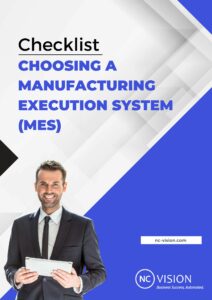
In the fast-paced manufacturing industry, businesses seek effective tools to optimize operations and boost productivity. NC-Vision actively engages in extensive analysis, benchmarking its Manufacturing Execution Systems (MES) against other vendors in the market. By evaluating unique features and capabilities, this comprehensive analysis empowers manufacturers to make well-informed decisions tailored to their specific needs and goals, enabling them to select the most suitable software tool for enhancing operations and driving productivity.
In the rapidly changing manufacturing industry, businesses are actively searching for effective tools to enhance their operations and maximize productivity. One of the essential components in this pursuit is the implementation of Manufacturing Execution Systems (MES).
To support manufacturers in creating their customized applications and solutions, NC-Vision is constantly engaged in extensive analysis of various software tools available on the market. Through this benchmarking process, we aim to compare and evaluate the unique features, capabilities, and differentiating factors of NC-Vision alongside other vendors.
By examining the strengths and weaknesses of NC-Vision and its counterparts, our objective is to provide manufacturers with the necessary insights to make well-informed decisions that align with the specific needs and goals of their manufacturing businesses.
This comprehensive analysis aims to empower manufacturers in selecting the most suitable software tool for enhancing their operations and driving productivity.
Shortcomings of Low-Code
The limitations of low code systems become evident as the graphical editor quickly reaches its modeling capacity. When the complexity of the business logic increases slightly, most low code applications become challenging to edit and reach their limitations fast.
Actual users say “The low code platform substantially restricts the developer’s ability to create applications with any level of complexity”*.
As a result, resorting to traditional coding/scripting becomes necessary. However, the reliance on hundreds of scripts over time becomes overwhelming, making the solution incredibly difficult and often impossible to maintain adequately.
Having to rely on traditional coding
This brings along numerous drawbacks, including heavy reliance on individual developers, persistent problems with outdated legacy code, and a shortage of programming resources. These limitations can hinder progress, increase dependency, and lead to inefficiencies within the development process.
Absence of Predefined Table Structure
Many low-code platforms lack a predefined table structure, meaning there is no integrated database. This creates challenges for users in effectively organizing and structuring their data, resulting in potential confusion and inefficiency.
Limited UI Flexibility
The entire user interface of most no/low code providers applications is confined within SBox (selection box), with no possibility to open dialogs.
Limited Database Query Capabilities
Joining data from multiple tables and performing sub-queries is either impossible or demands advanced SQL skills. Users of these applications are restricted to using filters and aggregations on a single table or relying on IT experts for their querying needs.
No Ready-to-Use Standard Applications Many low code providers only offer customers basic templates that require extensive development on their part. The absence of readily available solutions highlights the limited offerings of these providers, placing the burden squarely on the customer to invest significant time and effort into further developing the application. Actual users say they “wish it had more ‘plug and play’ type of capabilities”*.
No Integration Between Available Apps
The user experience is fragmented and frustrating. Actual users comment that such systems “lack standard data models and out of box functionality to operate as a primary MES software”*.
Cumbersome Data Insertion & Updates
With most low code providers the process of inserting and updating data in tables is cumbersome and time-consuming when it is required to add data in multiple tables at the same time.
Difficult Variable Tracing
Tracing and understanding the flow of variables within many low code providers is challenging.
*according to Gartner Peer Group Reviews
Our Unique Approach
Simplified Development
NC-Vision’s platform NC-Builder empowers developers to create applications of varying complexity without resorting to traditional coding. By completely eliminating the need for scripting, maintenance becomes streamlined, ensuring your solutions are easily manageable and up-to-date.
Pure No-Code Approach
Business professionals can fully leverage their knowledge and expertise directly, unlocking access to a vast pool of programming resources. This enables teams to tap into a diverse range of talents and perspectives, leading to increased productivity and fostering a culture of innovation.
Comprehensive Application Toolbox
Enjoy a wide range of useful standard applications with our extensive collection, providing practical utility and versatility beyond simple templates.
Seamless Integration for Enhanced User Experience
Experience a unified and cohesive user experience as our applications are seamlessly integrated with each other, eliminating fragmentation and streamlining workflows.
Built-in Database Structure
Benefit from a predefined table structure and integrated database, enabling easy organization and efficient data management without any confusion.
Advanced Query Capabilities
Access powerful query capabilities including joining data from multiple tables and utilizing sub-queries, enabling users to access and analyze data comprehensively.
Simplified Business Logic Editing
Easily edit and adapt complex business logic without limitations, as our platform allows for easy editing and scalability without limitations.
Efficient Data Insertion and Updates
Save time and effort with our streamlined process for inserting and updating data across multiple tables simultaneously, eliminating cumbersome and time-consuming tasks.
Flexible and Intuitive User Interface
Enjoy a customizable user interface that goes beyond selection boxes, providing the freedom to open dialogs and tailor the interface to your specific needs.
Streamlined Variable Tracing
Gain insights and effortlessly trace the flow of variables within our no--code platform, simplifying the understanding of complex processes and promoting efficient development.
Your Roadmap to Manufacturing Excellence
We’ve compiled this MES checklist to help you get started. Choose what works for you, add any requirements you have.












